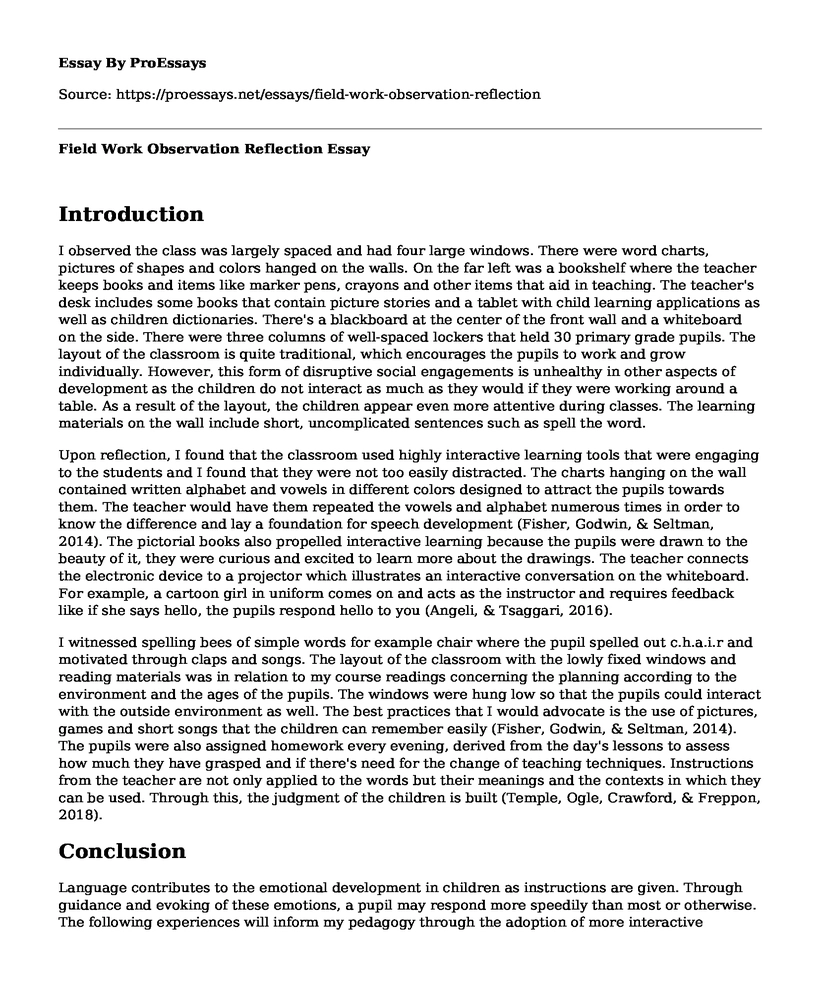Introduction
I observed the class was largely spaced and had four large windows. There were word charts, pictures of shapes and colors hanged on the walls. On the far left was a bookshelf where the teacher keeps books and items like marker pens, crayons and other items that aid in teaching. The teacher's desk includes some books that contain picture stories and a tablet with child learning applications as well as children dictionaries. There's a blackboard at the center of the front wall and a whiteboard on the side. There were three columns of well-spaced lockers that held 30 primary grade pupils. The layout of the classroom is quite traditional, which encourages the pupils to work and grow individually. However, this form of disruptive social engagements is unhealthy in other aspects of development as the children do not interact as much as they would if they were working around a table. As a result of the layout, the children appear even more attentive during classes. The learning materials on the wall include short, uncomplicated sentences such as spell the word.
Upon reflection, I found that the classroom used highly interactive learning tools that were engaging to the students and I found that they were not too easily distracted. The charts hanging on the wall contained written alphabet and vowels in different colors designed to attract the pupils towards them. The teacher would have them repeated the vowels and alphabet numerous times in order to know the difference and lay a foundation for speech development (Fisher, Godwin, & Seltman, 2014). The pictorial books also propelled interactive learning because the pupils were drawn to the beauty of it, they were curious and excited to learn more about the drawings. The teacher connects the electronic device to a projector which illustrates an interactive conversation on the whiteboard. For example, a cartoon girl in uniform comes on and acts as the instructor and requires feedback like if she says hello, the pupils respond hello to you (Angeli, & Tsaggari, 2016).
I witnessed spelling bees of simple words for example chair where the pupil spelled out c.h.a.i.r and motivated through claps and songs. The layout of the classroom with the lowly fixed windows and reading materials was in relation to my course readings concerning the planning according to the environment and the ages of the pupils. The windows were hung low so that the pupils could interact with the outside environment as well. The best practices that I would advocate is the use of pictures, games and short songs that the children can remember easily (Fisher, Godwin, & Seltman, 2014). The pupils were also assigned homework every evening, derived from the day's lessons to assess how much they have grasped and if there's need for the change of teaching techniques. Instructions from the teacher are not only applied to the words but their meanings and the contexts in which they can be used. Through this, the judgment of the children is built (Temple, Ogle, Crawford, & Freppon, 2018).
Conclusion
Language contributes to the emotional development in children as instructions are given. Through guidance and evoking of these emotions, a pupil may respond more speedily than most or otherwise. The following experiences will inform my pedagogy through the adoption of more interactive materials, mainly pictures because it will enhance understanding and memory (Sato, 2014). I would also engage these materials as they have proven to be a useful tool in building nonverbal cues from the response that the children have towards learning.
References
Angeli, C., & Tsaggari, A. (2016). Examining the effects of learning in dyads with computer-based multimedia on third-grade students' performance in history. Computers & Education, 92, 171-180.
Fisher, A. V., Godwin, K. E., & Seltman, H. (2014). Visual environment, attention allocation, and learning in young children: When too much of a good thing may be bad. Psychological science, 25(7), 1362-1370.
Sato, M. (2014). What is the underlying conception of the teaching of the edTPA?. Journal of Teacher Education, 65(5), 421-434.
Temple, C. A., Ogle, D., Crawford, A., & Freppon, P. A. (2018). All children read Teaching for literacy in today's diverse classrooms. Pearson.
Cite this page
Field Work Observation Reflection. (2022, May 21). Retrieved from https://proessays.net/essays/field-work-observation-reflection
If you are the original author of this essay and no longer wish to have it published on the ProEssays website, please click below to request its removal:
- Summary of the Findings on Intercultural Competence of Teachers
- My Dream Job After Graduation Essay
- Essay on a Childhood Dream Realized: Pursuing Pediatric Dentistry
- Studying Abroad: Personal Statement
- Essay Example on Theories of Human Intellectual Development: An Overview
- Student Success Initiatives - Free Essay Example
- Gifted and Talented - Free Essay Sample







